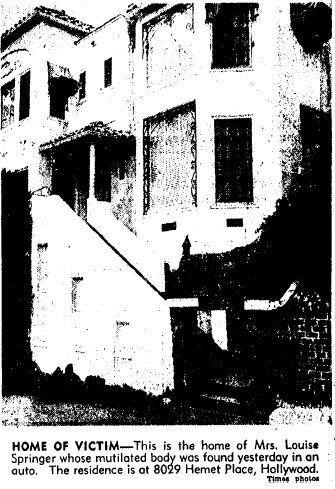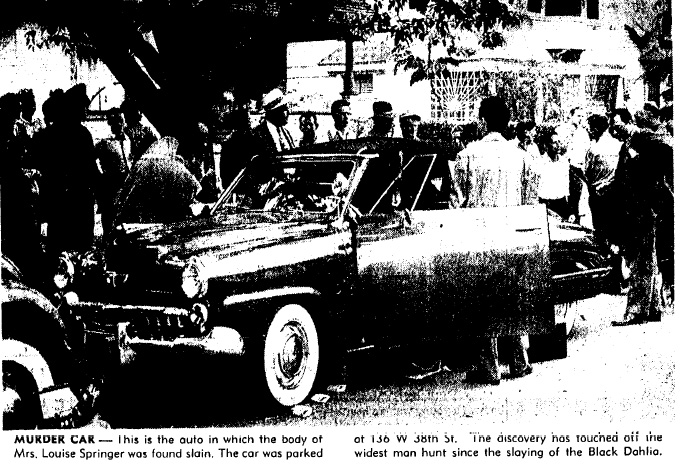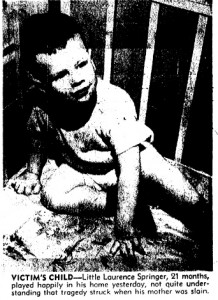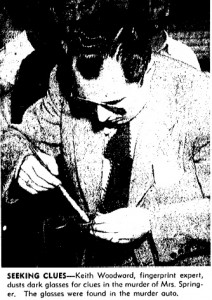 June 16, 1949, the decomposing body of thirty-five year old Louise Springer, a beauty shop operator, was found huddled in the rear seat of her husband’s convertible automobile parked at 125 W. 38th Street. Springer had been garroted.
June 16, 1949, the decomposing body of thirty-five year old Louise Springer, a beauty shop operator, was found huddled in the rear seat of her husband’s convertible automobile parked at 125 W. 38th Street. Springer had been garroted.
A length of clothesline was knotted around Springer’s neck, with two knots under her
left ear. Her face was swollen and nearly black. Her brown skirt and yellow suede
jacket had been twisted around her body, with her skirt tangled around her hips.
 A stick 14 inches in length and 1/2 inch thick had been violently driven into her vagina .
A stick 14 inches in length and 1/2 inch thick had been violently driven into her vagina .
Laurence Springer had reported his wife missing about sixty hours before her body was discovered. Louise, a hairstylist, had been working until shortly before 9:00 p.m. on the night she disappeared. Laurence had arrived to pick her up from work and take her to their beautiful home in the Hollywood Hills.
He’d parked in a lot on Crenshaw across the street from the shopping center in which Louise worked. The couple walked to their 1948 convertible and Louise, who had spent hours on her feet, pulled off her shoes and put on a pair of slippers that she kept in the car. They were just about to head for home when Louise exclaimed: “Oh, I’ve forgotten my glasses.” Laurence told her to relax and listen to her favorite radio show while he went to retrieve her specs.
Laurence got Louise’s glasses, then stopped to buy a magazine and chat with a friend. He wasn’t gone for more than 10 or 15 minutes, but when he returned both Louise and the car were gone.
Laurence knew that something was wrong, she wouldn’t have driven off and left him. He looked around for a few minutes but he couldn’t find his wife. He called the cops at about 10:00 pm and a few moments later a prowl car met him at the parking lot. The officers looked around but they didn’t find anything either. Laurence accompanied the police to the University Division Station where he filed a missing persons report. He then went home to be with his 21 month old son.
The Springer’s housekeeper and nanny, forty-nine year old divorcee Elizabeth Thompson, nearly collapsed when she received the news of her employer’s disappearance. Thompson told police that the Springers were happily married and that as far as she knew they had no enemies. She said that the couple had sold the beauty shops they owned in Northern California, then moved south to L.A. They hadn’t been in town for very long before Louise was slain. 
Thompson injected a note of mystery into the investigation when she said that she had received an obscene phone call from an unknown woman about three months prior to Louise’s disappearance. The caller asked several times for Thompson to identify herself, which she refused to do — then the caller made a lewd proposal and Thompson hung up on her. Cops didn’t believe that the phone call had anything to do with Louise’s disappearance, but during the initial stages of the investigation they couldn’t rule anything out.
 One of the most disturbing aspects of the case was that the parking lot from which Louise Springer had been abducted was only about a block away from the lot where the body of Elizabeth Short had been discovered in January 1947!
One of the most disturbing aspects of the case was that the parking lot from which Louise Springer had been abducted was only about a block away from the lot where the body of Elizabeth Short had been discovered in January 1947!
Women were terrified by the thought that the Black Dahlia’s killer was once again hunting the streets of L.A. for victims. An enormous manhunt, the largest since Short’s murder, was soon underway.
Witnesses in the neighborhood where Louise’s body had been found came forward to say that they had seen a man in the murder car and watched him as he seemed to adjust something on the backseat – which is where Louise’s body had been found covered with a tarp. A man was seen exiting the car, and some people thought that he may have been wearing a military uniform.
 Police forensics investigators were having a difficult time trying to determine if Louise had been slugged before she was strangled, or if she’d been sexually assaulted. A relatively new test called the acid phosphatase test was used to try to determine if semen was present, but the test was inconclusive due to decomposition.
Police forensics investigators were having a difficult time trying to determine if Louise had been slugged before she was strangled, or if she’d been sexually assaulted. A relatively new test called the acid phosphatase test was used to try to determine if semen was present, but the test was inconclusive due to decomposition.
The main piece of physical evidence, the twig that was violently inserted into Louise’s vagina, was becoming a huge problem for investigators — it couldn’t be identified. Bonnie Templeton, curator of the botany department at the County Museum, had been called in to lend her expetise in identifying the twig. She said that it could have come from “four of five” species of trees or shrub.
It was beginning to look as if the LAPD was going to have another unsolved homicide of a woman on the books.
NEXT TIME: The investigation into the murder of Louis Springer continues.

I don’t think any of these murders are related, I just think the nut cases were having a field day and the police just couldn’t keep up. Fingerprints from the car? This is fun!
I don’t think that the murders are related either. I believe that in Post-War L.A. there were enough damaged vets
and transients to account for the spike in violent crime.
I don’t think this case is related I believe this case is related to the murder 9 yrs later of crime writer James ellroy mother murder jean ellroy…..I believe the same man that beat raped,and strangled this woman Louise Springer resurface 9 years later and killed jean ellroy in El Monte cal in June of 1958..the two murders do have damn near all the same mo style of how the killer murder his victim…for one Louise Springer was first beated if u look at the same way jean ellroy was beated, Louise Springer raped.then you examine jean ellroy murder she was raped and murdered both of these victims was strangled to death with a clothesline cord only differences are only one of those was strangled with a nylon stocking and the other one wasn’t…jean ellroy when they founded her the other thing that do not have no relation to Louise Springer murder are she didn’t have anything stuffed down her throat but her dress was tangled up to her chest and if u look at how Louise Springer was founded with a jacket round her if u look at jean ellroy case she had a jacket put over her Louise Springer skirt just like jean ellroy dress tangled up playing one of the main roles in what was used doing both murders so I do believe the killer of jean ellroy in 1958 nick name the swarthy man killed Louise Springer in 1949.for the fact the killer mo are one using a clothesline and two physically assaulting both victims before he rape and killed both Louise Springer and jean ellroy… Louise Springer case are related to the black dahlia murder it’s related to jean ellroy murder 9 yrs later
Jean ellroy didn’t have anything stuffed down her throat like Louise Springer did that’s the only thing that don’t match the case excuse my typo error
The Louise Springer murder is not related to the black dahlia it’s related to the jean ellroy murder 9 yrs later excuse my typo once again
One thing I forgot to add that would make enough sense and that is that it won’t no shred of evidencea that proved that Louise Springer was raped tho her body was too decomposed to determine that notion other then her skirt being in that position around her hips but I believe that it have occurred
I tend to agree that a lot of crimes allegedly “related” to the Dahlia probably are not, but it’s interesting to me that Roscoe Cox lived at 1611 N. Orange. That’s where Beth Short lived the fall before her death.
There are many uncomfortable coincidences surrounding Short’s murder. One of the LAPD’s main suspects, Leslie Dillon, had an aunt who lived on Crenshaw and he often drove through the neighborhood where Short’s body was found. Thank you for your comment!
Hi, E.J.
Could you share with me how you know Elizabeth once lived there?
Thank you!
Did Louise work in The Broadway Store or The May Co?
Ellen – Neither. Louise was a beauty shop operator. Best — Joan
I disagree, Don’t see how it is possible that that all of the Lone Woman murders in 1940s LA were ALL separate murderers! At least a few must be the same individual (s)
Daisy — there’s never been a credible link between the unsolved homicides of women during the 40s — that’s not to say that something won’t come to light in the future, but of course with each passing year it becomes less likely. If you think about L.A. during the war years and in the post-war period it doesn’t seem so far-fetched that the homicides could have been one-offs. The population was transient: war workers, servicemen (some of whom came home with serious emotional issues) and when you put a large group of rootless people in their 20s in such an environment I think it can become volatile and perhaps even deadly.
I can’t see how you can say that the cases aren’t related. All of them young white(one Mexican) women, killed by strangulation or being beaten or both, killed in the night, and dumped publicly so that they could be easily found. All cases unsolved. It’s clear that a serial killer was prowling the streets of LA.
There is no way that Black Dahlia was the first victim of her killer. No way that a 1st timer would carry out the gross mutilations that were inflicted on her body.
I respect your opinion–however I don’t agree with your conclusion. One of the reasons I can say cases are not related is that I was fortunate to have seen LAPD’s files on Short’s murder when I assisted in curating an exhibit on the Black Dahlia case at the Los Angeles Police Museum and there was nothing I saw that would lead me to believe that her slaying was connected to any of the other unsolved homicides of women in L.A. during the 1940s. Of course it’s always interesting to speculate. There are several “daddy did it” books and everyone seems to have a theory — me included. But in the end it is all just a thought exercise because I believe that we will never know who the killer was. Thanks for reading the blog and for your comment. Best – Joan
Sadly, all the reasons you think these cases assess connected (all white, young, killed in they night, strangled, beaten, etc.) describes the vast majority of murders in general. You said it yourself, there’s no way the black dahlia was done by a first timer. Many of the line woman victims disappeared after her, many of whom weren’t ever found. Thissis completely contradictory to what we saw with dahlia. Her murder was gruesome, took time, thought, and patience. Her body was left, very publicly displayed, in a manner suggesting (in my opinion) the killer wanted everyone to know she was a whore, or worthless. With her legs spread, fake smile cut into her face, breasts and body horribly maimed. Typically serial killers progress in their “art” of killing. Getting more creative and cruel. They don’t typically digress from horribly maiming and very publicly displaying bodies, to strangling and/or hiding the bodies with either the intention of them never being found or being discovered in a not-so-public manner (e.g. stuffed in the back seat of a car). It’s very likely this killer had much practice before dahlia, of that we can agree. I just don’t see any evidence to suggest her murder was related too any of the others in the lone woman cases. Facial lacerations? Dismemberment? Disembowelment? Mutilation in general? Very public displays of the bodies? I just don’t see it.
I am totally addicted to your site. Every story you have posted is so interesting, I love to do a little investigating my self on these unsolved crimes you post. Keep up the good work 🙂
Estrellita, Thank you so much for reading the blog! I love that you’re inspired to do some investigating on your own. If you find anything, please let me know.
Best,
Joan
I think Steve Hodel had it right in his FIRST book (Black Dahlia Avenger): his father, George Hodel, likely did the following murders:
1.Ora Murray 1943
2.Georgette Bauerdorf 1944
3.Elizabeth Short 1947
4.Jeanne French 1947
5.Lillian Dominguez 1947
6.Gladys Kern 1948
7.Mimi Boomhower 1948
8.Jean Spangler 1948
9.Louise Springer 1949
——————————–
But Steve, in subsequent books, went off the deep end in assigning the Lipstick murders, the Zodiac murders etc. to Dr Hodel. There were some psychological resemblances but it’s difficult to kill Californians when you live in Hawaii, the Philippines, and Japan. Besides, the Zodiac was big-boned man who was in the 220 to 250 pound range.
So, his hypothesis helped him. And then hurt him.
I agree that Steve Hodel’s subsequent books entered into some unbelievable territory. George Hodel was an absolutely vile individual, but I’m still not convinced he ever committed a single murder, let alone multiple. Still, he makes an interesting suspect.
Best,
Joan
After reading numerous books, articles and seeing videos, on the Black Dahlia, I have to ask the most important question that no one, to my knowledge, has ever remarked upon:
MOTIVE!
Isn’t it the #1 reason the police look to in every murder? So what was the motive in killing Beth Short? Who could have had such a hate for her?
I also believe that a murder this heinous, this violent, was blatenly personal! Even the most vicious of serial killers rarely subject their victims to something like this.
And Steve Hodel is just a steaming pile of horsesh*t. In all the years since the murder, he never said squat about it until he finds some photos, allegedly belonging to his father, who look NOTHING LIKE Elizabeth Short! Yet he swears they are her.
C’mon. Even a blind man could see he’s fishing without a hook.
Johnny,
You’re right, motive is the elephant in the room. There is a lack of a traditional motive in this case. It wasn’t about money, it was highly unlikely to have been a jealous boyfriend. I don’t think she knew her killer. The way in which she was killed, and her body dumped, is missing some of the components one might expect to find if the killer was someone she knew. She may have had a nodding acquaintance with her killer, if that. In sexually motivated homicides, which is what I think her killing was, the reasons for the act is as complex and unique as the killer’s fantasies. That’s why such murders are difficult to solve, even today.
As for Steve Hodel, the original photo that triggered his investigation into his father was proved not to be Elizabeth Short. Her surviving sisters said it was not her and, in fact, the woman whose photo it actually was turned up alive. Your summation is perfect, he is fishing without a hook.
Thank you for sharing your thoughts on this endlessly fascinating case.
Best,
Joan
Even if they were not related exactly with Dahlia ( I don’t know), they might have been related to each other. There are too many commonalities, the stick shoved inside, the strangulation, the leaving for dead, the notes to the police. There were others you don’t have listed. One Viola Norton (36) was abducted by two men in a car, beaten slashed, and left for dead. She survived. I found these woman as I was writing my blog on a newspaper site. She was dumped blocks from where Elizabeth Short was dumped. Another was Marion Newton (36) she was a Canadian divorcee. The paper only said she was criminally assaulted and her dead body dumped on Torrey Pines. I am sure there are more. I only looked around the other women dates of death. I would not have believed as much as I do if I had not been around and read about the Hillside Strangler. I think there may have been more than one.
Patricia,
It is possible that some of the homicides may have been committed by the same person You mentioned other women who made the unsolved list during that period. Those murders, and others, were a big reason for the 1949 Los Angeles Grand Jury probe into the Dahlia case. They wanted an explanation from police as to why the crimes remained unsolved. The best answer is that they were stranger murders (still notoriously difficult to solve). The Grand Jury may have continued their probe had they not been distracted by the LAPD vice scandal. That story, and madam Brenda Allen, dominated the news for quite a while.
The Hillside Strangler case is one of the most heinous in the city’s history. The stuff of nightmares.
Thank you for writing.
Best,
Joan
Of course there are similarities & differences inside the urban mythology of the Los Angeles werewolf murders during the 1940’s. I’d say it’s highly unlikely they’re all connected, however it is possible some are committed by the same person. Yet it’s probably not relevant to the investigations whether they are connected or not. A person can only speculate from the gathered information & those factors eventually becomes overwhelming by sheer volume of data. When actually the most important elements are the missing bodies of Mimi Boomhower & Jean Spangler or recovering physical evidence such as the personal effects from the victims.
My point is while it is important to review the cases to formulate a hypothesis it’s still more accurate and productive to simplify the investigations by focusing on the missing persons and lost items than rehashing information everyone already knows over & over….
I’d rather use my time considering answers like what happened to Elizabeth Short’s missing shoe,clothing etc. Same can be said regarding any of the victim’s missing objects. Mostly I think how important it is to find the missing persons & provide closure to the friends & family.
Who knows IF there was really a serialized killing going on or not or IF it’s even relevant? What is certain is that there’s still missing people & potential physical evidence out there to be found.